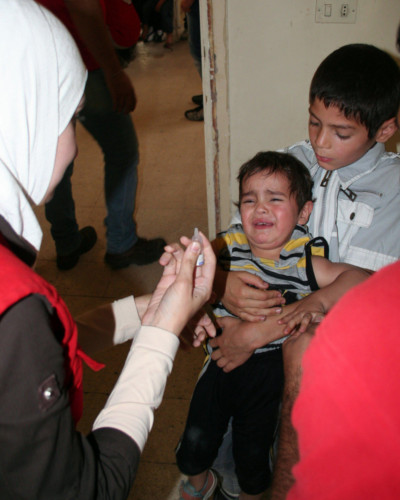Using AI to control energy for indoor agriculture
30 September 2024
Published online 25 February 2015
With no new cases recently reported, the WHO says its efforts to contain Syria’s polio outbreak are working, but experts are reluctant to declare it has been wiped out.

© Tribune Content Agency LLC / Alamy
“The likelihood is that if a sensitive surveillance system is looking for polio and can’t find it for a year, there is no polio, but given the circumstances in Syria and Iraq we are cautious,” says Chris Mayer, manager for polio eradication and emergency support at WHO.
Mayer says that although the transmission of wild poliovirus has ostensibly been halted in Syria and Iraq, “a further phase of outbreak response is recommended for both countries for the coming six months.”
During 2013, there were 36 new cases of polio reported in Syria, which had previously been declared free of the disease. A subsequent WHO-led immunisation campaign targeted 27 million children across the region, several times.
But some health experts are doubtful that Syria has really been rid of the virus, contending that monitoring polio under the circumstances there is difficult. Efforts have been hampered by ongoing violence which led to children being missed, as well as delayed and incomplete testing and verification of suspected cases.
Public health and polio specialist, Annie Sparrow, says she has “low grade confidence” in the WHO’s report, citing serious limitations with getting stool samples to laboratories for formal diagnosis.
She says that the Syrian opposition’s humanitarian arm, the Assistance Coordination Unit (ACU), which has been vaccinating children in northern Syria, reported 105 cases of acute flaccid paralysis (AFP) in 2014 and there was only 63% stool adequacy. So because of a lack of adequate facilities and the challenges of diagnosing the poliovirus in Syria, many cases have not been fully confirmed, she explains.
“The absence of laboratory evidence of wild poliovirus cannot be said to mean the absence of polio in this setting where accurate surveillance is impossible and where clinically compatible cases of polio are not reported,” she says.
Sparrow adds that she had no confidence in the accuracy of the Syrian government’s surveillance and reporting of polio, citing its persistent denial when the virus first appeared in Deir ez-Zor. The WHO heavily relies on government surveillance and its Early Warning Alert and Response Network, which relies on a network of volunteers and health facilities inside Syria for vaccination and reporting.
It is dangerous to trust that the infection can be kept out of the region, if vaccination does not provide immunity. It may just be ‘waiting’ to come back.
Adam Coutts, a researcher at the London School of Hygiene and Tropical Medicine who has studied the crisis on the ground, welcomed the news from the WHO, but noted the dearth of information coming from areas controlled by the Islamic insurgents known as ISIS.
He reiterates Mayer’s assertion that the vaccination campaign was very effective but stressed it must continue despite deteriorating conditions.
“The challenge is now to sustain these campaigns and strengthen health information systems and support local NGOs, despite an ever-worsening security situation, increased movement of people, declining sanitation conditions and reduced aid budgets,” he says.
In an editorial published in late 2013, Martin Eichner from the department of Medical Biometry at the University of Tubingen in Germany warned that the re-emergence of polio in Syria could endanger nearby regions for years to come. With only one in 200 people infected developed paralysis, there could be a year of “silent transmission” before an outbreak is detected.
More than a year later, Eichner refers to previous simulation studies he has run in which he increased vaccination coverage and then looked at the time periods between two occurrences of polio outbreaks.
“Periods of one year without disease were an extremely weak indicator for extinction,” he says, adding that it was only after three years had passed without incidence that the probability was very high (more than 95%) that it had been eradicated.
“It is dangerous to trust that the infection can be kept out of the region, if vaccination does not provide immunity. It may just be ‘waiting’ to come back,” he adds.
Meanwhile, WHO’s Mayer concedes that some cases of polio in Syria could have been missed due to constant refugees movement, and difficulty reaching populations most at risk. “There remains a risk that some residual transmission may still have been missed; additionally, the continuing intense transmission of polio in Pakistan means the risk of another importation of the virus remains high.”
Sparrow says that the measles vaccine mix-up which led to the tragic deaths of 17 children late last year has increased parental refusal to vaccinate children. There is also often no cold chain – linked refrigerated facilities needed to keep the oral vaccine viable.
While a new polio vaccination campaign was scheduled to start in late February, it has been suspended, along with a planned measles campaign, following the measles deaths.
“Syrian children pay the price,” says Sparrow. “The problem goes well beyond polio.”
doi:10.1038/nmiddleeast.2015.38
Stay connected: